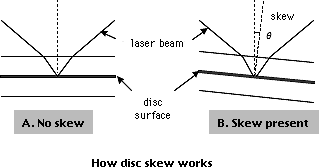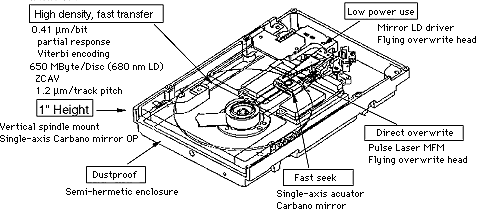
Contents

In order to help you understand the recording technology used in the HS drive, particularly the direct-overwrite feature, we have prepared a graphic that illustrates the four types of recording technology currently in use.
Phase-change technology (part A), is used in PD disks. This relies on using the laser's heat to change the phase-change layer of the disk back and forth between a crystalline and non-crystalline state, thereby indicating a bit of data. (Although phase-change disks normally are rewritable, this approach might be called Light Intensity Modulated overwrite). Data is recorded magneto-optically, using both the heat of the laser plus an external magnetic field, so direct-overwrite requires modulating both optic and magnetic systems.
The ISO standard for 640 MB MO disks (part B) is also optically modulated, and writes over previously-stored bits by applying a constant external magnetic field while using a laser to write the data. In this format, the ability to overwrite data is achieved by having a separate write-layer and magnetic erasure layer, each with different properties, on the same disk. When the disk is new, all of the magnetic erasure layer has the "erased" polarity. Shining a low-power laser causes the write-layer to magnetize the erasure layer, and a high-power beam causes the write-layer to reverse the polarity on the erase-layer, thereby recording a bit of data.
Magnetically modulated systems (parts C and D) achieve direct-overwrite by shining a DC-powered laser while modulating the magnetic field.
Part C shows the system used by Mini Discs (MD). Part D improves on this with the laser-strobe magnetic field modulation, which is the technology used in HS drives.
The figure below helps illustrate the specifics of how the laser-strobe magnetic field modulation system works.
First, the laser is turned off for a period of time (t0-t1) during which the magnetic field is raised to a level sufficient for writing data.
Second, the laser is pulsed on at time t1. This raises the temperature on the current spot on the disk above the Curie temperature (at which it loses its magnetization), and the previous datum is erased.
Third, the laser switches off at time t2 and the temperature in the recording layer drops below the Curie point. This "freezes" the new polarity into the recording layer, thus writing the new datum. This is how the first pit (d1) is created. The edge position of the recorded bit is determined by the time at which the laser pulse shuts off.
Fourth, the laser remains off from time t2 to time t3, during which time the magnetic field is reversed. The second pit (d2) is created during the time between the laser coming on again at time t3 and shutting off at time t4. The magnetic field should remain stable and saturated during this interval, so that pit-formation is not dependent upon field-reversal speed.
Raising the laser pulse's cycling speed will cause one pit to overlap with the next, leaving only the trailing edge of the pit. This can be used to advantage by only reading data at the trailing edge of pits: this approach means that in theory, pits can be packed arbitrarily closely within a track.
If we consider the four formats in terms of how amenable they are to increased data densities, we see that types A (phase-change) and B (optical modulation) have an upper limit imposed by the width of the laser beam. The width of the recorded pits is determined by the beam's power, so that raising the density while still being able to accurately detect the pit edge requires that fluctuations in the laser's power be kept carefully in check, which raises problems of its own. But the overlapping that magnetic field modulation (as illustrated in the earlier figure) allows a density greater than the beam size would otherwise allow. In conventional MFM (in part C), the formation of edges between pits is dependent upon the speed with which the field modulates, making it susceptible to jitters and making higher data densities a challenge. But laser-strobe MFM (in part D) eliminates this problem, since the magnetic field's modulation is synchronized with a laser pulse. The pit edge is no longer dependent upon the magnetic field reversal speed, but rather on the laser beam's timing, leaving very little susceptibility to jitters.
Unlike PD disks and ISO-standard disks which use continuous composite servo method, the HS disk format uses sampled servo method. In sampled servo method, dataregions and servo regions are spatially separate and handled independently. The following figure shows the different ways in which tracking information is recorded.
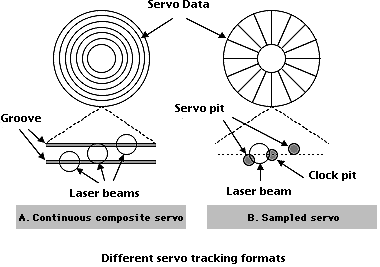
In the continuous composite servo system shown in part A, a track is bounded on each side by the grooves, and the primary beam, which reads and writes data, is kept on more or less on track by two secondary beams which constantly shine on the grooves. A control system works to ensure that there is a constant amount of light being reflected from the grooves onto its lens. This is known as the three-beam system.In contrast to this, the servo system shown in part B relies on special regions of the disk, which contain "servo-bytes" and are embossed at regular intervals.The servo-bytes contain "clock pits", used for generating a clock-signal, and "servo-pits", used for detecting tracking errors. As long as the laser beam strikes two servo-pits, the same amount of light will be reflected onto the control system's lens, showing that the beam is tracking properly. In short, the servo-pits have the same net effect as the two secondary beams in the three-beam system, but the servo-signal detection laser and the main read/write laser can be combined, simplifying the optics. Having the servo regions and data regions are separate eliminates some problems of continuous composite servo systems, where the amount of light reflected during the data-writing process may fluctuate, or there will be differences in the reflectance of embossed sections of the disk and user-written sections.
The second part of this figure shows the different ways in which the clock signal is generated.
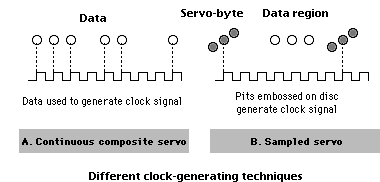
In the continuous composite servo system, the drive itself has a master clock which is used to time the writing of data. When the data is read back, the drive extracts a clock signal from the data. This is called "self-clocked" modulation (this includes systems where the special clock-signal data is encoded after the data signal is written). In the sampled servo format, a clock pit is embossed in the servo domains. These clock pits generate the clock signal, and ensure almost perfect timing. Since the servo regions containing the clock pits are separate from the data regions, the clock signal is not dependent upon the read data, which is unlike continuous composite servo systems, and helps protect the timing signal from jitters. Furthermore, since the clock signal is separate from the data, the data can be encoded using different techniques.Another advantage that the sampled servo format holds for the HS disk is ease of manufacturing, since HS ROMs and Partial ROMs need no tracking groove.
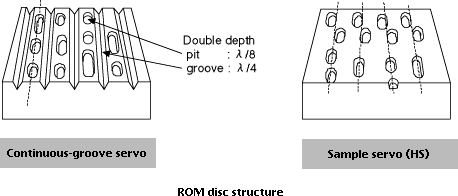
The format uses a red laser at a wavelength of 685 nm and has zone-CAV optics with a numerical aperture of 0.55. These particulars allow us to pack 650 MB, the same amount of data as a single-sided CD-ROM contains, onto a 3.5" disk. Furthermore, with a shorter wavelength of light and improved optics, higher data densities will become available, although this requires tighter skew margins (the allowable angular deviation from perpendicular in the angle formed by the disk surface and beam). We found that using a thinner disk substrate than usually found in magneto-optical disks, 0.8 mm, we could alleviate this problem. As the figure shows, if the disk surface is not perpendicular to the beam, the beam path will deviate, causing the shape and location of the spot struck by the beam to be off. Making the disk thinner minimizes the beam path's deflection when there is skew.
